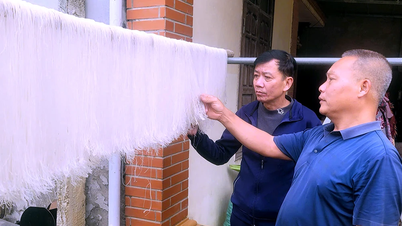A 35-year-old woman in Nghe An was diagnosed with precancerous cervical lesions early thanks to the CINtec Plus test.
This is a new technique deployed for the first time in Vietnam, opening up an important step forward in screening and stratifying cervical cancer risk accurately and promptly.
 |
| Illustration photo. |
Patient LTM, residing in Nghe An, came to MEDLATEC Nghe An General Clinic after receiving a positive qualitative HPV test result while preparing for her second artificial insemination at a reproductive support facility. Worried about her health, she proactively went to the medical facility for a thorough examination.
Through medical history, the doctor discovered that she had never been screened for cervical cancer before, and was currently suffering from primary infertility of unknown cause. Clinical examination showed that her vagina had little white, lumpy discharge that adhered to the vaginal wall and cervix, and that her cervix showed signs of mild inflammation.
The HPV test results showed that the patient was positive for 1 of 12 high-risk HPV types, but negative for types 16 and 18, the two most common types associated with cervical cancer. At the same time, the cervical cytology test (Thinprep) showed no abnormalities.
With these two results, many cases are often classified for periodic monitoring without requiring immediate intervention. However, to more accurately assess potential risks, doctors have ordered the CINtec Plus test, an important step forward in cervical cancer screening.
A positive CINtec Plus result changed the entire course of treatment. Based on the abnormal biomarkers, the doctor performed a colposcopy and biopsy.
Microscopic images showed that the cervical squamous epithelium had signs of dysplasia, large, distorted nuclei, high nuclear/cytoplasmic ratio, and apolarization disorder, typical of high-grade cervical squamous intraepithelial lesion (CIN2+). Immediately after that, the patient was indicated to perform the LEEP procedure to remove the lesion and simultaneously treat the vaginal and cervical inflammation caused by fungus.
According to MSc. Nguyen Thi Trang, Obstetrics and Gynecology specialist, MEDLATEC Nghe An General Clinic, CINtec Plus is a test that simultaneously detects two biological markers p16 and Ki-67 on the same cell.
In particular, p16 is a manifestation of high-risk HPV invasion causing cell dysregulation, while Ki-67 shows that cells are proliferating abnormally. When these two markers appear at the same time, the risk of high-grade precancerous lesions is very high, allowing doctors to identify early malignant transformation in cervical cells even though the cytology is still "normal".
Without the indication of CINtec Plus, Ms. M's case could have been placed in the periodic monitoring group and missed the golden period for treatment. This clearly demonstrates the role of CINtec Plus in increasing diagnostic accuracy, clearly stratifying risks, limiting unnecessary biopsies, and is especially suitable in cases with unclear screening results.
The World Health Organization (WHO) and the American Society for Cervical Cancer (ASCCP) have recommended the use of CINtec Plus as an important follow-up test after HPV screening or Pap smear.
Many studies around the world have shown that CINtec Plus helps reduce up to 24% of unnecessary colposcopy indications, while improving the ability to detect precancerous lesions early. The Vietnamese Ministry of Health has also updated this technique in the guidelines for cervical cancer prevention and control.
Currently, MEDLATEC Healthcare System is the pioneer in implementing CINtec Plus testing in Vietnam, with a strict process from consultation, sampling, analysis to returning results, ensuring high accuracy thanks to modern machinery and a team of experienced experts.
The CINtec Plus test is indicated in cases such as positive high-risk HPV but normal cytology; positive HPV of unknown type; abnormal cytology but negative or undetermined HPV; need for colposcopy but cannot perform due to medical conditions; atrophied cervix or lesions located deep in the cervical canal making colposcopy difficult to perform.
Source: https://baodautu.vn/phat-hien-som-ton-thuong-tien-ung-thu-nho-xet-nghiem-moi-d362868.html























![[Photo] Politburo works with the Standing Committee of Da Nang City Party Committee and Quang Ninh Provincial Party Committee](https://vphoto.vietnam.vn/thumb/1200x675/vietnam/resource/IMAGE/2025/8/19/b1678391898c4d32a05132bec02dd6e1)
![[Photo] General Secretary To Lam attends the inauguration and groundbreaking ceremony of 250 projects to celebrate National Day](https://vphoto.vietnam.vn/thumb/1200x675/vietnam/resource/IMAGE/2025/8/19/3aa7478438a8470e9c63f4951a16248b)
![[Photo] General Secretary and Prime Minister visit the National Exhibition and Fair Center](https://vphoto.vietnam.vn/thumb/1200x675/vietnam/resource/IMAGE/2025/8/19/f4503ad032d24a90beb39eb71c2a583f)




![[Photo] President Luong Cuong's wife and Queen of Bhutan visit Tran Quoc Pagoda](https://vphoto.vietnam.vn/thumb/1200x675/vietnam/resource/IMAGE/2025/8/19/62696af3852a44c8823ec52b03c3beb0)






















![[Maritime News] Maersk announces positive results in the first half of 2025](https://vphoto.vietnam.vn/thumb/402x226/vietnam/resource/IMAGE/2025/8/20/d9f3704e9e8647a0ade1f6e2309d75d1)











































Comment (0)